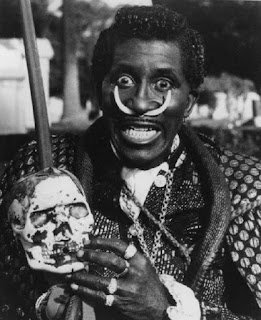Adelina Poerio as the homocidal dwarf in
Don't Look Now (dir. Nicolas Roeg, 1973)
Don't Look Now (dir. Nicolas Roeg, 1973)
He felt himself held, unable to move, and an impending sense of doom, of tragedy, came upon him. His whole being sagged, as it were, in apathy, and he thought, 'This is the end, there is no escape, no future.'
- Daphne du Maurier, 'Don't Look Now'
I suppose we've all felt like that on occasion (if not daily). But from out of such despair great art - including great pop music - is born. Indeed, the last line seems to invoke the 1967 track by The Doors ...
Initially written about a failed romance and the pain of saying goodbye to a loved one, 'The End' evolved into something much more grandiose, to do with the loss of childhood innocence, death, and Oedipal fantasy.
Some critics have described it as Sophoclean. Others have said it's more Joycean in its lyrical playfulness and eclectic frame of reference; that Morrison demonstrates what happens when the stream of consciousness is tainted with acid.
For many people, me included, the song is forever linked with the movie Apocalypse Now (dir. Francis Ford Coppola, 1979), which brilliantly remixed the track from the original master tapes, bringing to the fore Morrison's astonishing vocals (including his liberal use of scat and expletives that are almost inaudible in the '67 recording).
In sum: great tale; great track; great movie. And one can't help wondering what (if anything) Miss du Maurier made of the latter works? I know she liked Nicolas Roeg's 1973 film Don't Look Now, based on her short story, but what of The Doors epic and Coppola's masterpiece? I think we should be told ...*
See: Daphne du Maurier, 'Don't Look Now', in Don't Look Now and Other Stories, (Penguin Books, 2006), p. 14.
It's interesting to note that the line quoted also uses the phrase no future, as if anticipating the punk nihilism of the Sex Pistols and not merely recalling the psychedelic nihilism of The Doors.
Play: The Doors, 'The End', from the album The Doors (Elektra, 1967): click here. And to hear the remixed version used in Apocalypse Now, click here.
*Although we can't be sure, I doubt that Miss du Maurier would've been a fan of Jim Morrison and The Doors, as a scene in 'Not After Midnight', possibly indicates. The narrator of the tale, Timothy Grey, who is on holiday in Crete, sits outside a café savouring what is known as local colour and amused by the passing crowd; "Greek families taking the air, pretty, self-conscious girls eyeing the youths [...] a bearded Orthodox priest who smoked incessantly at the table next to me [...] and of course the familiar bunch of hippies [...] considerably longer-haired than anybody else, dirtier, and making far more noise. When they switched on a transistor and squatted on the cobbled stones behind me, I felt it was time to move on." See Don't Look Now and Other Stories, p. 73.
It's interesting to note that the line quoted also uses the phrase no future, as if anticipating the punk nihilism of the Sex Pistols and not merely recalling the psychedelic nihilism of The Doors.
Play: The Doors, 'The End', from the album The Doors (Elektra, 1967): click here. And to hear the remixed version used in Apocalypse Now, click here.
*Although we can't be sure, I doubt that Miss du Maurier would've been a fan of Jim Morrison and The Doors, as a scene in 'Not After Midnight', possibly indicates. The narrator of the tale, Timothy Grey, who is on holiday in Crete, sits outside a café savouring what is known as local colour and amused by the passing crowd; "Greek families taking the air, pretty, self-conscious girls eyeing the youths [...] a bearded Orthodox priest who smoked incessantly at the table next to me [...] and of course the familiar bunch of hippies [...] considerably longer-haired than anybody else, dirtier, and making far more noise. When they switched on a transistor and squatted on the cobbled stones behind me, I felt it was time to move on." See Don't Look Now and Other Stories, p. 73.











